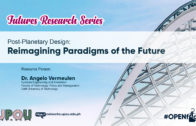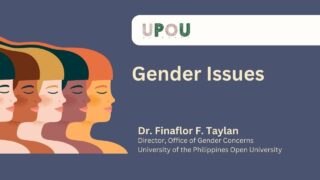Aquaculture and its Impacts on Biodiversity
Ms. Angel Queenee Dequito
Almost everybody loves seafood. Garlic butter shrimp, baked mussel, milkfish relleno, steamed oyster, and chili crabs. Thanks to aquaculture we can satisfy our cravings any time we want!
Seafood supply and market profit are the main reasons why I studied aquaculture. But. mind you, I almost got discouraged pursuing aquaculture. It was when our professor discussed about aquaculture being the culprit of mangrove loss in the Philippines. Mangrove areas had been converted to brackishwater ponds as supported by the Philippine government as part of the fishpond development program in the country from [the] 1950s to 1960s, and continued until the 1980s to support intensive shrimp farming. This indeed increased seafood production and turned out to be profitable. However, losing mangrove ecosystems also means losing the goods and services it provides. Not only that, we have another problem to deal with—and that is biodiversity loss.
As stated in Ecosystems and Human Well-Being of Millenium Ecosystem Assessment, biodiversity contributes directly and indirectly to many constituents of human well-being, including security, basic material for a good life, health, good social relations, and freedom of choice and action. Many people have benefited over the last century from the conversion of natural ecosystems to human-dominated ecosystems and the exploitation of biodiversity. At the same time, however, these losses in biodiversity and changes in ecosystem services have caused some people to experience declining well-being, with poverty in some social groups being exacerbated.
James Diana in Bioscience Journal listed the following negative effects of aquaculture as threats to biodiversity.
Number one, escapement of aquatic crops and their potential hazard as invasive species.
The Philippine aquaculture has been enhanced by species introduction, such as Oreochromis or tilapia, Clarias or catfish, and Cyprinus or carp. Many aquaculture commodities are exotic species which means these species are transported outside their natural habitat. Mozambique tilapia or Oreochromis mossambicus was introduced into the Philippines from Thailand in 1950. Common carp or Cyrpinus carpio was introduced into the Philippines from Hong Kong in 1915.
The danger happens when these exotic species can escape from the culture system, been released to the environment, reproduce, compete with the native species, and eventually dominate in the area. Invasive species can affect the population of other native species or worse; [it] can replace the native species thriving in the area.
The potential of many aquaculture species to become invasive is high, since invasive species and aquaculture species shared similar characteristics or traits such as a widely distributed original range, a broad environmental tolerance, high genetic variability, short generation time, and rapid growth.
Number two, the relationships among effluents, eutrophication of water bodies, and changes in the fauna of receiving waters.
Effluents from aquaculture systems contain high levels of nutrients—dissolved and particulate—resulting from products of metabolism and uneaten food. This may affect bodies of water adversely, as this may cause eutrophication, or positively as additional nutrients can boost natural productivity.
The direct effect of increasing nutrients in [an] aquatic system is to increase growth rates of primary producers. Increasing productivity generally corresponds with a shift among groups of primary producers and habitats from benthic periphyton, epiphytes and macrophytes to phytoplankton. When growth rates of primary producers exceed rates of consumption, large quantities of deceased organic material can also accumulate in the system. Decomposition of accumulated dead phytoplankton, aquatic macrophytes, zooplankton and other organic material can result in oxygen depletion known as hypoxia. Eutrophication, therefore, changes the amount of biomass in aquatic systems, its spatial distribution and allocation among trophic levels and taxa. Consequently, eutrophication alters the entire biological structure of an aquatic ecosystem, along with its physico-chemical conditions.
Number three, conversion of sensitive land areas such as mangroves and wetlands, as well as water use.
Conversion of land areas for aquaculture and other anthropogenic activities such as deforestation, agricultural, industrial, and urban development all contribute to habitat destruction or habitat loss. What would happen to the organisms if their homes were destroyed? Hmm.
Estimated to cover 400,000 to 500,000 hectares at the turn of the century, Philippine mangroves have decreased by more than half to 240,800 hectares as of 2010 due to overexploitation by coastal dwellers, and conversion to agriculture, salt ponds, industry, and settlements. Among these factors, aquaculture remains the major cause, as mangroves declined at the rate of 5,000 hectares per year in the 1950s through the 1970s when the government promoted a pro-aquaculture policy.
The Philippine government and NGOs develop programs that focus on mangrove replanting and rehabilitation. The Zoological Society of London and our Filipino scientists, for example, published a manual on mangrove reversion of abandoned and illegal brackish water fishponds.
Number four, other resource use, such as fish meal and its concomitant overexploitation of fish stocks.
Do you know that aquaculture feeds contain fish meal and fish oil? Fishermen do not harvest fishes solely for human consumption but also for sustaining aquaculture industries. Yes! Imagine how many bags of feeds are consumed daily to sustain aquaculture farms.
About 28.3 million metric tons of seafood harvested in 2003, including 5.2 million metric tons of fish meal, were used for purposes other than human consumption. About 46% of this fish meal and about 81% of the fish oil produced in 2002 went into aquaculture. Given the current rates of aquaculture growth and the rising importance of intensive aquaculture, forecasts are for even higher demands for fish meal.
Fish meal commonly comes from small pelagic species of fish, whose harvest can reduce the population of its predator. Higher demand for fish meal may also cause overexploitation of captured species resulting in the decline of biodiversity.
Number five, disease or parasite transfer from captive to wild stocks.
Aquaculture has been the fastest growing sector of food production meeting the demand of the world’s growing population. With the technological advancement, intensification of existing facilities, and expansion into new areas contributes largely to the development of aquaculture. However, accompanying this development in aquaculture system are problems that [need] the aid of fish health management plans.
Population size and density of pathogens and parasites are more likely to increase in an intensive aquaculture. The negative impact of aquaculture to biodiversity is in terms of transmission of the disease or parasite from cultured or captive stocks to wild stocks. This usually occurs in cages and pens where captive and wild stocks share the same water resource.
Amyloodinium ocellatum (an ectoparasitic dinoflagellate) infestations have been recorded in temperate and tropical countries causing fish cultures to suffer. Trophonts, the feeding stage of Amyloodinium ocellatum, commonly attached on skin, fins, eyes and gills, can interfere with gas exchange, osmoregulation, and tissue integrity, thus, resulting to spasmodic gasping, uncoordinated movements, and extensive mortalities of fishes.
Introduction of parasite-contaminated water source to the culture system and vice versa, from the effluents of culture system to nearby bodies of water can cause Amyloodiniosis to wild fin fishes. To prevent disease outbreak, effective filtration system and proper sanitation procedures must be applied.
Number six, antibiotic and chemical use, which may influence aquatic species near aquaculture facilities
Antibiotics are drugs of natural or synthetic origin that have the capacity to kill or to inhibit the growth of micro-organisms. Antibiotics that are sufficiently non-toxic to the host are used as chemotherapeutic agents in the treatment of infectious diseases. Some antibiotics used in aquaculture are Oxytetracycline for medicated feed, Florfenicol, Sarafloxacin, and Erythromycin. These are used for the treatment of, for example, diseases caused by Aeromonas, Pseudomonas, and Streptococcus bacteria.
Antibiotics used in aquaculture as one of the fish health management strategies may exert selection pressure to local bacterial populations. Positively, this may enhance bacterial biodiversity, in which the frequency of novel recombinant and mutant genotypes will increase but negatively, as this will also result in the production of antibiotic-resistant strain bacteria. The increasing use of chemical treatments in aquaculture is likely to lead losses of biodiversity through destabilization of ecosystems subjected to effluents. This also affects food safety and consumer health. Bacteria that show multiple resistances to antibiotics can actually spread from animals to humans and even cross geographic borders.
Other negative impacts of aquaculture to biodiversity are genetic alteration of existing stocks from escaped hatchery products and predator mortality caused by, for example, killing birds near aquaculture facilities.
Oh no! Does aquaculture really have negative impacts to biodiversity? I have to convince myself to love aquaculture.
Here are some facts we’d love to know:
Number one, fish production from aquaculture can reduce pressure on wild stocks, which may be overexploited.
Instead of catching such aquatic species from the wild, aquaculture can provide us tons and tons of supply. This will reduce our reliability to harvested stocks from the wild and this benefits biodiversity.
According to Food and Agriculture Organization, as stated by James Diana in Bioscience Journal, aquaculture production of Atlantic salmon has increased dramatically, from almost none in 1960 to 1.2 million metric tons in 2005. Historically, Atlantic salmon was a capture fishery producing up to 16,000 metric tons per year; the peak harvest occurred in 1990, but by then many populations had declined dramatically. Now, cultured salmon have largely replaced captured salmon in the market, which has brought down the market price of Atlantic salmon. Now, cultured salmon have largely replaced captured salmon in the market, which has brought down the market price of Atlantic salmon, allowed cultured products to be substituted for captured ones, and apparently contributed to the rebound of some local fish stocks. This rebound has occurred after many interventions, including intentional restocking of natural populations with hatchery-reared fish, breeding by escaped fish from aquaculture systems, reduced demand for wild stocks because of their declining market value, and reductions in harvests due to many management interventions.
Good point number two! stocking organisms from aquaculture systems may help to enhance depleted stocks with limited reproductive success.
Application of aquaculture technology through restocking, stock enhancement, and sea ranching coupled with reduction in fishing effort and fish habitat restoration promise to help restore lost production and possibly increase harvests from capture fisheries.
Sea ranching or ocean ranching is a type of fish farming in which juvenile fish are released into the ocean to grow unprotected and unassisted to be subsequently harvested.
Research on the development of sea ranching systems had been done in the Philippines especially on sea cucumbers. Sea cucumber is a highly vulnerable shallow resource that can be obtained by gleaning in the shallows, and is very accessible to those without the means to invest.
Number three, effluents and waste from aquaculture can increase local production, abundance, and diversity of species.
As I have mentioned earlier, effluents and waste from aquaculture may affect bodies of water adversely, as this may cause eutrophication, or positively, as additional nutrients can boost natural productivity.
And, number four, destructive land-use patterns, such as slash-and-burn agriculture, may be replaced by more sustainable patterns, such as aquaculture in ponds, which also may generate income, reduce poverty, and improve human health.
Aquaculture has both positive and negative impacts to biodiversity and this challenged me to explore this field more. We do not want to forget about the advantages of aquaculture as well as we do not want to destroy biodiversity. Can you think of ways, strategies, or solutions that will help reduce the negative impacts brought by aquaculture to biodiversity? Can you state existing laws in the Philippines that have been effectively enforced for us to achieve environmentally sound and sustainable aquaculture?
Martinez-Porchaz and Martinez-Cordova in their article entitled World Aquaculture: Environmental Impacts and Troubleshooting Alternatives in The Scientific World Journal, said:
Many strategies have been suggested, evaluated, and/or proven in order to advance in the sustainability of aquaculture. Basically, all of them respond to the criticisms and are possible solutions to the problems attributed to the activity. The main aspects that have to be performed to advance toward such goal are the correct selection of the farming sites and species; the implementation of the most adequate culture system; use of the best feed and feeding practices; the use of bioremediation systems; decreasing the dependence of fishmeal and fish oil; adequate management of the effluents; achieving certification of compliance with sustainability, and improving research and legislation related to evaluation and solutions for aquaculture impacts.
How useful was this resource?
Click on a star to rate it!
Average rating 0 / 5. Vote count: 0
No votes so far! Be the first to rate this post.
We are sorry that this post was not useful for you!
Let us improve this post!
Tell us how we can improve this post?

























